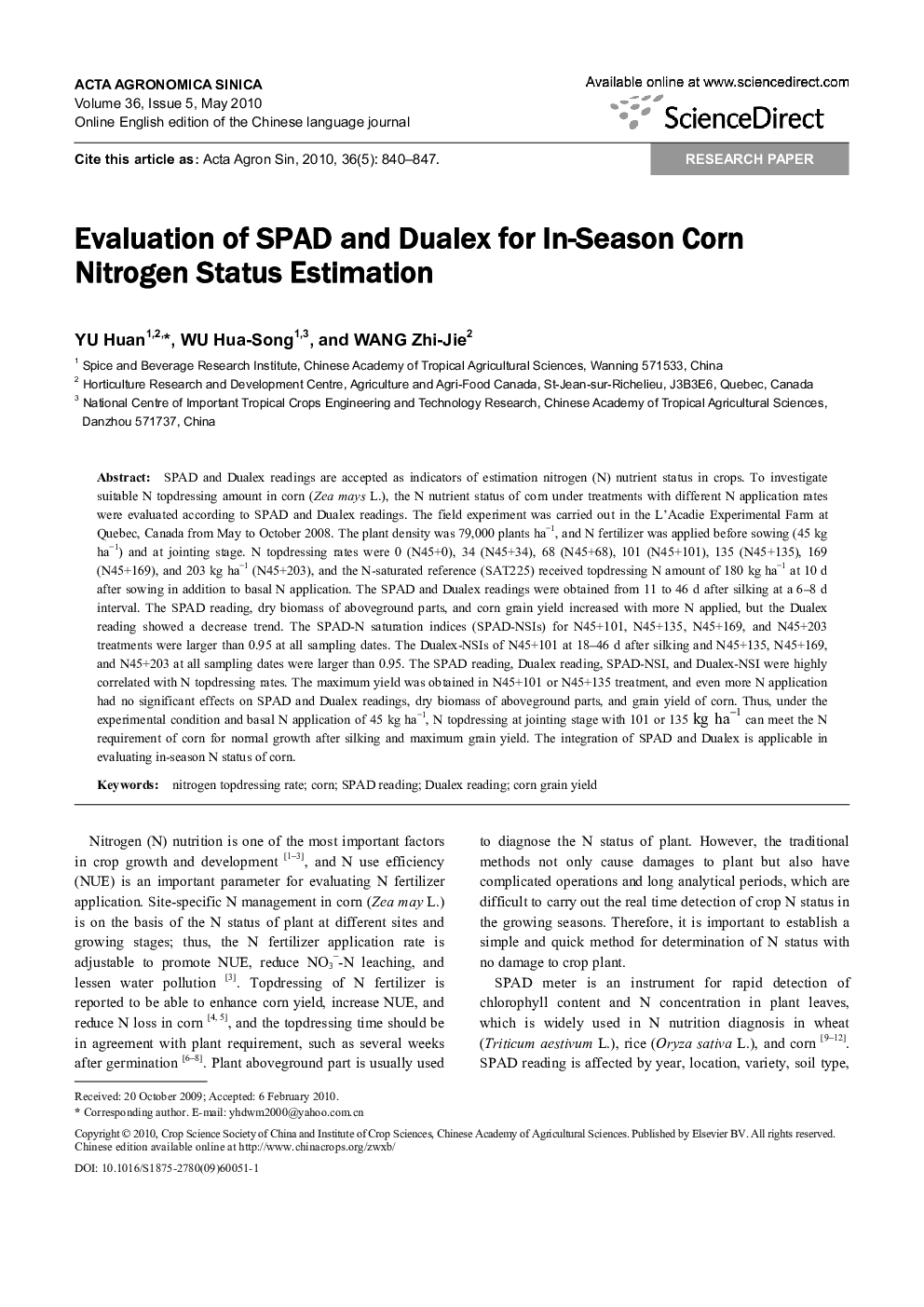| Article ID | Journal | Published Year | Pages | File Type |
|---|---|---|---|---|
| 4503309 | Acta Agronomica Sinica | 2010 | 8 Pages |
SPAD and Dualex readings are accepted as indicators of estimation nitrogen (N) nutrient status in crops. To investigate suitable N topdressing amount in corn (Zea mays L.), the N nutrient status of corn under treatments with different N application rates were evaluated according to SPAD and Dualex readings. The field experiment was carried out in the L'Acadie Experimental Farm at Quebec, Canada from May to October 2008. The plant density was 79,000 plants ha−1, and N fertilizer was applied before sowing (45 kg ha−1) and at jointing stage. N topdressing rates were 0 (N45+0), 34 (N45+34), 68 (N45+68), 101 (N45+101), 135 (N45+135), 169 (N45+169), and 203 kg ha−1 (N45+203), and the N-saturated reference (SAT225) received topdressing N amount of 180 kg ha−1 at 10 d after sowing in addition to basal N application. The SPAD and Dualex readings were obtained from 11 to 46 d after silking at a 6-8 d interval. The SPAD reading, dry biomass of aboveground parts, and corn grain yield increased with more N applied, but the Dualex reading showed a decrease trend. The SPAD-N saturation indices (SPAD-NSIs) for N45+101, N45+135, N45+169, and N45+203 treatments were larger than 0.95 at all sampling dates. The Dualex-NSIs of N45+101 at 18-46 d after silking and N45+135, N45+169, and N45+203 at all sampling dates were larger than 0.95. The SPAD reading, Dualex reading, SPAD-NSI, and Dualex-NSI were highly correlated with N topdressing rates. The maximum yield was obtained in N45+101 or N45+135 treatment, and even more N application had no significant effects on SPAD and Dualex readings, dry biomass of aboveground parts, and grain yield of corn. Thus, under the experimental condition and basal N application of 45 kg ha−1, N topdressing at jointing stage with 101 or 135 kg ha−1 can meet the N requirement of corn for normal growth after silking and maximum grain yield. The integration of SPAD and Dualex is applicable in evaluating in-season N status of corn.
摘要为了探讨玉米生长过程中适宜的施氮量, 以加拿大玉米品种Pioneer 38B84为试验材料, 在底施氮为45 kg hm−1和基本苗7.9万株 hm−1条件下, 研究追氮量0、34、68、101、135、169和203 kg hm−1以及氮饱和参考小区等8个处理对吐丝后玉米穗位叶SPAD值、Dualex值、地上部生物量及产量的影响。结果表明, SPAD值、地上部生物量以及产量均随追氮量增加而增加, Dualex值随追氮量增加而降低。追氮101、135、169和203 kg hm−1处理的SPAD-氮饱和指数(SPAD-NSI)在各测定日期均大于0.95。追氮101 kg hm−1处理的Dualex-NSI在吐丝后18∼46 d大于0.95; 追氮135、169和203 kg hm−1各处理的Dualex-NSI在各测定日期均大于0.95。SPAD 值、Dualex 值、SPAD-NSI和Dulaex-NSI均与追氮量显著相关。在拔节期追氮101 kg hm−1 或135 kg hm−1即可满足玉米生长对氮素的需求, 获得最大的经济产量。当超过最大产量施肥量时, 氮肥用量的增加对SPAD值、Dualex值、地上部生物量以及产量均无显著影响。追肥不仅可达到与氮饱和参考小区同样的产量效果, 而且还可减少氮肥的施用量, 减少种植者的经济投入。在本试验条件下, 基施氮45 kg hm−1, 在拔节期适宜的追氮量为101 kg hm−1或135 kg hm−1。SPAD叶绿素仪与Dualex仪均可用来诊断玉米的氮素营养状况。
